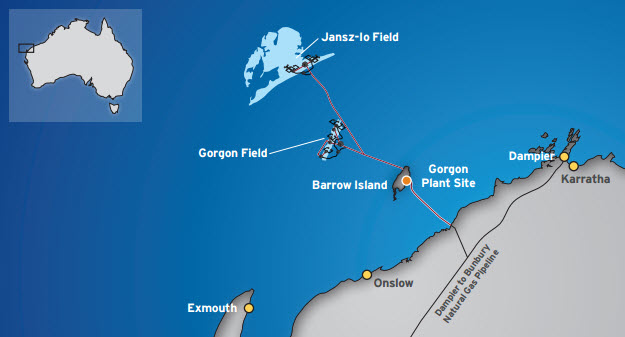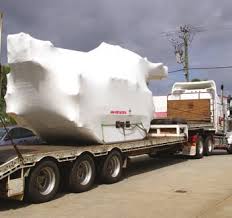First Gas from Gorgon
Chevron has started producing LNG and condensate at the Gorgon Project on Barrow Island off the northwest coast of Western Australia. The first LNG cargo is expected to be shipped next week.
The Gorgon Project is one of the world's largest natural gas projects and the largest single-resource development in Australia. The project also includes one of the world’s largest subsea gathering systems.
Chevron is positioned to become a major LNG supplier by 2020. In particular, Chevron's Australian projects are well located to meet growing demand for energy in the Asia-Pacific region and more than 80 percent of Chevron's Australian subsidiaries' equity LNG from the Gorgon and Wheatstone projects is covered by sales and purchase agreements and heads of agreements with customers in the region.
"We expect legacy assets such as Gorgon will drive long-term growth and create shareholder value for decades to come," said Chairman and CEO John Watson. "The long-term fundamentals for LNG are attractive, particularly in the Asia-Pacific region, and this is a significant milestone for all involved."
The Gorgon Project is supplied from the Gorgon and Jansz-Io gas fields, located within the Greater Gorgon area, between 80 miles (130 kilometers) and 136 miles (220 kilometers) off the northwest coast of Western Australia. It includes a 15.6 MTPA LNG plant on Barrow Island, a carbon dioxide injection project and a domestic gas plant with the capacity to supply 300 terajoules of gas per day to Western Australia.
The Chevron-operated Gorgon Project is a joint venture between the Australian subsidiaries of Chevron (47.3 percent), ExxonMobil (25 percent), Shell (25 percent), Osaka Gas (1.25 percent), Tokyo Gas (one percent) and Chubu Electric Power (0.417 percent).

The Upstream scope of the project includes:
• Drilling eight high-rate, big-bore development wells at the Gorgon Field and 10 at the Jansz-Io Field.
• A subsea gas gathering system and subsea pipelines that delivers gas from the Gorgon and Jansz-Io fields, located about 65 and 130 kilometers respectively off the west coast of Barrow Island.
• Pipelines that run from the shore crossing on the west coast of Barrow Island across to the east coast, where they tie-in to the gas treatment plant.
• A domestic gas pipeline that runs more than 90 kilometers from Barrow Island to the Western Australian mainland where it ties-in to the existing Dampier to Bunbury Natural Gas Pipeline.
Downstream – Onshore Facilities
• A three-train, 15.6 MTPA LNG processing plant.
• Domestic gas processing plant.
• LNG and condensate storage.
• Marine facilities including a 2.1 kilometer materials offloading facility (MOF) and 2.1 kilometer long LNG jetty.
• Operations and maintenance buildings
• Workforce accommodation village and associated infrastructure.
Carbon Dioxide Injection
The Carbon Dioxide (CO2) Injection Project involves the design, construction and operation of facilities to inject and store reservoir CO2 into a deep reservoir unit, known as the Dupuy
Formation, more than two kilometers beneath Barrow Island. This will reduce greenhouse gas emission from the Project by approximately 40 percent. The Australian Government has committed $60 million to the Gorgon Carbon Dioxide Injection Project as part of the Low Emissions Technology Demonstration Fund.
Environmental Protection
The Gorgon Project set a new standard in environmental performance. Barrow Island is a Class A nature reserve and every vessel delivering materials to the island has had at least two crew members trained in fauna watch. The vessels must give way to animals such as turtles and whales without interfering with their natural behavior.
All vessels have used baits and traps to ensure that they do not carry non-indigenous species to the island, and nothing must go overboard. They have had to hold their ballast water or perform deep sea exchange prior to entry to Barrow Island, and construction vessels working within the area have to have their ballast tanks cleaned of sediment prior to commencing operation.
 To protect the unique ecosystems on and around the 91-square-mile (235-square-kilometers) island, a rigorous quarantine management system was developed. The system pioneered a risk-based quarantine approach with more than 300 procedures, specifications, checklists and guidelines.
To protect the unique ecosystems on and around the 91-square-mile (235-square-kilometers) island, a rigorous quarantine management system was developed. The system pioneered a risk-based quarantine approach with more than 300 procedures, specifications, checklists and guidelines.
One of the initiatives includes more than 70 acoustic sensors being placed on the island to detect the non-native Asian house gecko. The sensors are tuned to listen for the distinctive chirp of the gecko, which hitchhikes on vessels and cargo and could threaten native gecko species.
Efforts to prevent invasive species from entering the island focused on screening all passengers, cargo and equipment for quarantine compliance prior to arrival. Quarantine detector dogs screened passengers and their luggage for insects, fresh fruit, vegetables, seeds, soil and other items.
Prior to transport, oversized machinery and equipment, including small buildings, were shrink-wrapped and pest control measures applied.
Project History
More than 200 exploration wells have been drilled in the Barrow sub-basin over the past 35 years, including West Tryal Rocks in 1972 and Spar in 1976 - both discovered by West Australian Petroleum (WAPET) which had been a pioneering company in the development of the Western Australian petroleum industry. WAPET was the operator on behalf of various joint ventures comprising Chevron, Texaco, Shell and Ampolex (the exploration division of Ampol). In 2000, Chevron became the operator of all WAPET's petroleum assets. WAPET discovered Gorgon in 1981 with the drilling of the Gorgon 1 well.
The Gorgon Project received preliminary environmental approvals from the West Australian government in September 2007 and from the Federal Minister for the Environment in the following month. The project developers then submitted revised plans to cover an expansion in the size of the project. Final environmental approval was received from the state government in 2009.
